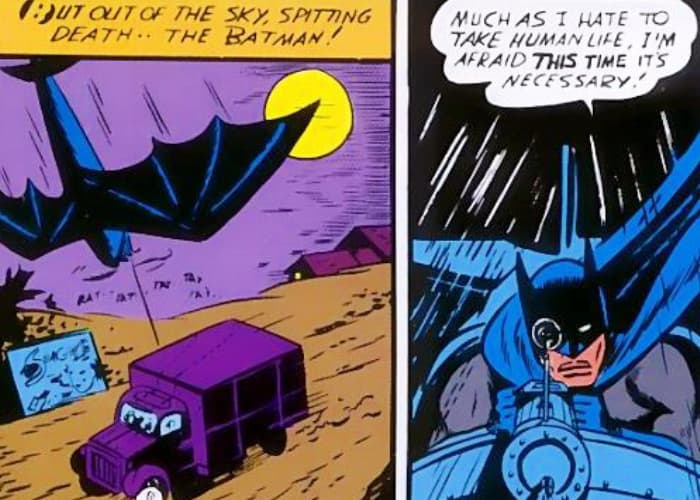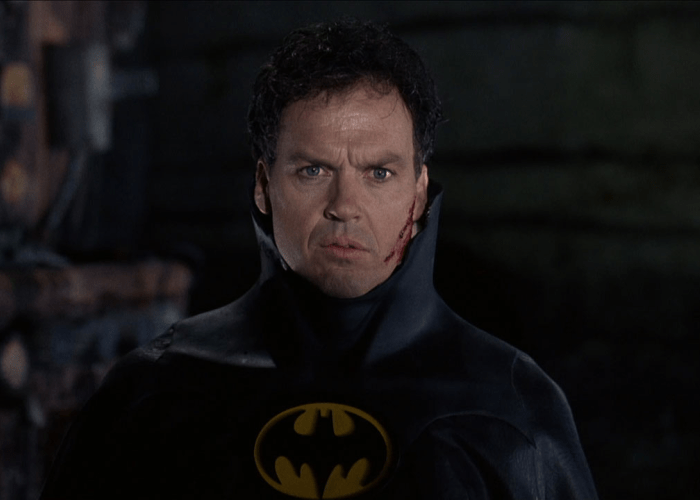A truck barrels down a clifftop road, speeding towards Gotham City. Caged in the back is a ten-foot-tall man-monster created by the mad science of Hugo Strange. The two henchmen in the cab are excited to unleash the brute upon the good citizens of Gotham; their goal is to score some quick cash from the bank while the police are distracted by the rampaging giant. Aboard his Batplane, The Batman swoops from the heavens with his finger gripped around a Vickers machine gun. He consoles himself and the reader before pulling the trigger, “Much as I hate to take human life, I’m afraid this time it’s necessary!” RAT–TAT–TAT–TAT–TAT!
Ventilated, the truck smashes into a tree. The man-monster falls out the back, but before he can get his bearings, The Batman drops a noose around his neck. The Batplane rises into the air taking the struggling creature with it. “A few moments later…” The man-monster’s body goes limp. “He’s probably better off this way,” says The Batman while pulling a knife from his utility belt. He relieves the corpse weight from the Batplane and tracks down another man-monster terrorizing a Gotham highrise. The Batman makes quick work of this one, blasting him with gas pellets, toppling the beast to his doom, and shrugging his shoulders when Hugo Strange vanishes. Next time, villain.
This scene occurs over twenty-two panels on two and a half pages of Batman #1 published in March of 1940. It was not the first, nor the last time Batman killed an opponent. I don’t highlight this moment to champion Zack Snyder’s recent Q&A comments regarding his intense belief that The Dark Knight is a vigilante killer and that anyone who doesn’t believe that reality is “living in a fuckin’ dream world.” Lol. Comic books, literature, and movies are dream worlds by definition. That’s one of their great benefits, and I appreciate writers like Alan Kistler over at Polygon explaining exactly “Why Batman Stopped Killing People in 1940.”
I highlight this sequence from Batman #1 only to say that Bruce Wayne was one weird dude from the jump. I get it. His parents were gunned down in an alleyway when he was a boy, and the trauma damaged him irrevocably. There is no coming back from witnessing a horror such as that. Wandering around the globe, reshaping the body as well as the mind to prevent such traumas from affecting other little boys of Gotham is noble. Certainly, coming from an era that produced other such extreme crusaders like The Shadow, The Spider, and The Phantom.

Of course, minus one shoddy Alec Baldwin movie, brutes like The Shadow are pretty much forgotten in the current cultural landscape. Why is that? What makes OG DC Comics heroes like Batman and Superman last for 80 years and 1000 issues?
They’re damn weird.
A character can’t be one thing for eight decades. They can be a dark, grim avenger of the night for a few decades, disappear, reappear for a movie or two, and then fade back into oblivion. For a character to outlast the Energizer Bunny, they gotta adapt, evolve, or radically confront their nature repeatedly. The moment they commit to an essential ingredient is the moment they take their first step to destruction. Or, even worse, irrelevancy.
Bob Kane wanted in on the booming superhero business of 1939. His funny animal and serialized cartoons had reached their limit, but he saw potential in the Axis-smashers like Superman and Captain Marvel (the Shazam! version). Kane had a name and a vague idea for a spandex redeemer who concealed his identity behind a tiny domino mask. Thankfully, he hired ghostwriter Bill Finger to smooth over the designs, write up a history, a rogue’s gallery, and a universe to populate them.
The Batman began life as a crime-fighting imitation of pulp adventures, but by the 1950s he was a sci-fi explorer who was just as likely to trip the light fantastic as he was to slap a toxic spewing fish from The Joker’s mitts. Batman became necessarily weird to fight against allegations from fear-mongering fanatics like Dr. Frederick Wertham who’s book Seduction of the Innocent had Congress screaming for the eradication of such grotesque EC Comics titles like Tales from the Crypt and Vault of Horror. DC Comics saw the writing on the wall and demanded that Bat-writers find goofier, sunnier exploits for the dynamic duo to partake.

In Batman #113 (February 1958), one of my favorite of these oddball escapades, another Batman from the planet Zur-En-Arrh transports the Gotham City Batman to his homeworld. Bruce Wayne discovers that he now sports fantastic abilities on par with the Superman of Metropolis. Together the two Batmen battle hordes of diabolical robots hellbent on conquering Zur-En-Arrh. They defeat the invaders using a Bat-Radia, an electronic box that uses electro waves to penetrate their cloaking device. Victorious, the outer space Batman gives our Batman the Bat-Radia as a token of his appreciation. It’s a great trinket for the Batcave.
Jump ahead a decade, and Batman beams even brighter on television sets across the globe. The 1966 series created by William Dozier cast Adam West as the owner of stately Wayne Manor. In the first episode entitled “Hi Diddle Riddle,” Batman and Robin (Burt Ward) thwart The Riddler (Frank Gorshin) from stealing the Batmobile using anti-theft rockets. The bad guy never quite makes it into handcuffs, but the Caped Crusader manages to woo one of his henchwomen with his swanky Batusi dance skills. West would define the character as a camp icon, and it would take two decades before Batman would be seen as anything other.
Frank Miller’s The Dark Knight Returns, published in four premium format comics between February and June of 1986, envisioned Batman as an old exhausted watchdog who pulls himself out of retirement just before Gotham City descends into a gang war apocalypse. Between this storyline and Watchmen, no other comics have received as high praise or celebration. They are often cited as pulling the medium from the hands of children and transforming comic books into proper, serious, adult business. Watching Zack Snyder’s canon, it’s clear that dude was rocked by these stories, and it’s equally as clear experiencing the internet fallout of Batman v Superman: Dawn of Justice that popular opinion believes it’s time to move beyond the heyday of Frank Miller. There are lots more Batmen in the toy chest.

Batman needed Miller in 1986. That dose of ultraviolence allowed readers to consider the genuine psychological ruination that must parallel a person’s desire to dress like a bat and punch clown faced maniacs in the face. It was the perfect seed to plant in Tim Burton’s noggin when he took on the role of translating the whacky Adam West iteration into his goth aesthetic. The ’89 Batman leans hard into absurdity, meticulously artificial set-dressing, and broad emotions. Michael Keaton’s Bruce Wayne is a hurt manchild eager to drop bad guys from tall places until their plummeting corpses fill the hole in his heart. He makes time for kissy face with Vicki Vale (Kim Basinger), but none of us believed she would return for the sequel. He’s too busy spending his psychologist couch money on constructing Batplanes, Batboats, Bat-signals, Batarangs, and Batbombs.
In lasting 80 years, Batman picked up a lot of fans. Each one has an opinion on how The Dark Knight should act and behave, and it’s often based on the version of the character they first fell in love with. For me, that’s the animated series that ran from 1992-1995. Show co-creator Bruce Timm seemed to have an appreciation for all those weirdo rogues that fought for page space next to usual suspects like The Joker, The Riddler, and Catwoman. Yeah, yeah, yeah, those guys are great, but so are The Mad Hatter, Clayface, Firefly, and The Clock King. Timm was the kinda kid who watched the ’66 show and said, “Huh, Bookworm, he’s actually kinda cool.” He snatched up as many bad guys and their plots as he could, stuffed them into a Film Noir language, and delivered half-hour punch-ups suitable for all ages.
In the episode “Showdown,” Batman (Kevin Conroy) and Robin (Loren Lester) track Ra’s Al Ghul agents to an airplane hanger after they’ve kidnapped an elderly man from a retirement home. Along the way, they listen to a tape left by Ra’s who tells the story of cowboy bounty hunter Jonah Hex (William McKinney). The majority of the cartoon is a swashbuckling steampunk tale of transcontinental railroads and airships. Batman barely features in the thirty minutes, but he appears to take pride in Hex’s dogged pursuit of justice. By credits end Batman lets the history lesson percolate in his mind and allows Ra’s to keep his hostage (no spoilers here, but it’s a doozy).
All Batmen can’t be that, though. Not if I want him to stick around. Not if I want others to determine their own best Batman. One version is not better than another. They all just are what they are. The Dark Knight has fought muggers, traveled across dimensions, been the butt of the joke, and the mirthless crusader. Take the one that works for you and celebrate it. Or find one that’s utterly baffling and unpack it. May I suggest the two-dimension terror that is The Rainbow Creature as seen in Batman #134?
The post Keep Batman Weird appeared first on Film School Rejects.


0 comments:
Post a Comment